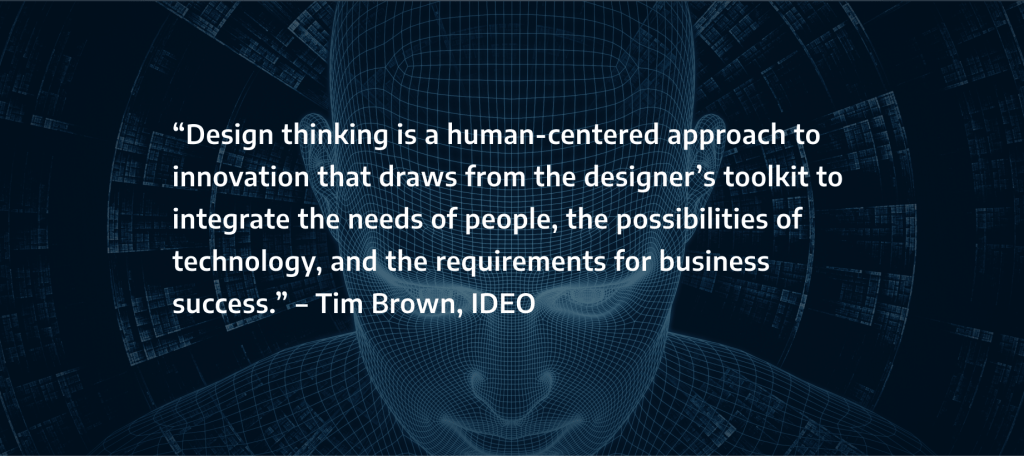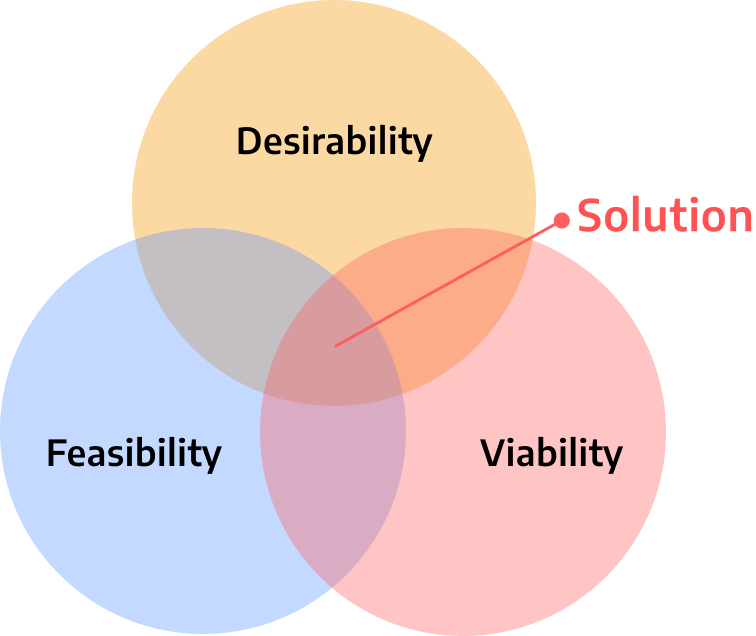There was a time when I was a young professional, when ideation was one of the most challenging parts of my work. Today, though, having spent enough years immersed in the business of solving problems with design solutions, I’ve come to realize that ideas come easy. With practice, you can train yourself to build the required muscle to generate multiple ideas. The real challenge is figuring out which of the ideas are the right solution for your client’s needs. An idea is only truly useful if it provides the required outcome, while being feasible, sustainable and meaningful for a specific need.
UberEats, AirBnB, Apple are some common brands that come up when Design Thinking comes up, as they have been pioneers in building entire businesses from a human-centric approach.
What is design thinking?
When you approach anything that needs a solution with an empathy-based problem solving stance, you’ll see that it is applicable and useful to issues across aspects of life. Design thinking is a way of seeing anything. It is a lens. An approach. Perhaps, even a philosophy? It doesn’t necessarily have to be a “design-specific” problem. At the heart of it is a human perspective that asks, what are we solving for? What difference will it make to the human being involved?
I first came across the term Design Thinking as early as 2008 when Tim Brown, CEO of global design and innovation company, IDEO, wrote about it in the Harvard Business Review, titled “Design Thinking”. Brown, and IDEO, have been credited with coining the term as we understand it today, but the truth is this way of thinking has been in practice for long before we had a specific term coined to accurately describe the process.

Being in the domain of designing user experiences, this specific approach has gained relevance for us. But academics say it has been used even in domains like architecture, engineering and business, for decades now. Which brings me to my next point.
Why is it for everyone?
Adopting a multi-pronged approach to thinking is increasingly relevant given that we live, work, play, interact in a more and more dynamic world where multiple realms intersect. Our pain-points are also dynamic and intersect other aspects of our lives. For example, I’ve been trying to simplify my diet such that I can prepare, cook and eat two healthy meals a day that give me my required calories with the desired macro-split. While the problem lies in the realm of health and lifestyle needs, the solution must also take into consideration the specific context and situations of my life: my lifestyle, paucity of time, proficiency in the kitchen, taste preferences.
I have solutions that make procuring (delivery apps) and preparing food (recipe apps, calorie-counting apps) slightly easier, but my biggest challenge is coming up with a set of meal ideas that provide variety and meet my primary need: required calories with the desired macro-split. If there were a solution that could provide suggestions day on day, or week on week, my life would be much easier.
ChefKraft is a meal-kit service that addresses some of my needs, to some degree.
This is a small example at the level of an individual. But the same can be extrapolated to some of the more bigger questions having significant consequences in the world today. Businesses, educational institutions, players in the development sector, governments are all finding new ways to navigate our increasingly global and diversified populations to meet their plural needs. How can we respond to crises rapidly? How can we predict patterns in climate change with greater accuracy? How can we cater to specific diverse and minority communities while also balancing the bigger eco-systems they exist in?
Imbibing a solutions-based approach which focuses more on the outcome, and the specific change required for the humans involved, rather than a problem-based approach which is more focused on removing obstacles, offers solutions that are wider in scope, sustainability and feasibility.

This is the fine line between ideating to address an issue, versus solving a problem for desired outcome from a human point of view. This approach can transform not just “design” but processes, strategies, services, products, interactions.

Some design thinking solutions I have encountered recently
- Making eco-consciousness accessible and easy on the user: Akshayakalpa is an organic milk supplier that has introduced a simple service to solve the issue of milk packets being added to landfills when they are thrown into the waste by consumers. Users can simply return milk packets in the same collection bag provided by the company for delivery of milk. This solution ensures that the business stays true to the promise of a sustainable and mindful attitude to the ecosystem involved, while also making it easy and accessible for customers to get on board to do their bit in the promise.
- Subscription packages for predictable purchases: Understanding the obvious predictability in purchase patterns of customers, Nua Woman – a brand making safe, chemical and toxin-free period products for people who menstruate – designed purchase plans that allow customers to subscribe to a pack of period products that take into account their specific needs in size of pad, quantities needed every month, frequency required. Giving the customer flexibility, customisation at reduced prices and removing the hassle of repeat purchases seems to have originated from the simple insight that people who menstruate, menstruate at a specific frequency.
- My partner and I have recently put into practice a simple, workable solution for the otherwise tedious job of saving expense invoices to track our expenses. This solution, once we implemented it, not only helped us track, but also bucket expenses into separate categories, and saved us the trouble of scouring through wallets, email chains and apps to retrieve invoice details at the end of the year when tax season rolls along. We do this in a dedicated email ID created for the express purpose of archiving all bills. Aptly titled “Universe Of Invoices” it is the archive/repository where we send snapshots of bills as soon as a transaction is made. This is a simple, sustainable and human solution to what was otherwise a cumbersome problem.
How does empathy-based thinking make a difference?
Probably the most important differentiator is that the design thinking process is not linear. Understanding this takes a shift in perspective. There are 5 phases in the process, but often times the process may go back and forth, with no linear progression: Empathise, Define, Ideate, Prototype, Test
For example, once the problem has been ideated and defined and you begin to prototype a possible solution, be open to the fact that you may stumble on something that will take you back to redefine the problem in a clearer way. This is not necessarily a regression, but a progression in the design process. An openness to problem-solving rather than moving through obstacles makes this a much more fluid, flexible and free-flowing process.
The emphasis on remaining human-centric means it is not rigidly reliant on data (what is measurable) alone, but also makes space to consider variation, emotion and intuition (which may not always be measurable) to find a healthy middle ground.
A heavy focus on empathy, means you begin to think of the real human beings that will eventually benefit from your solution. What are their pain-points, what are the various scenarios they operate in, what next steps will they encounter upon using said solution?
Whether thinking for your own business, a client requirement, a personal circumstance or social context, Design Thinking encourages creativity and innovation. It pushes us to think outside the patterns and predictable habits that we are aware of, thereby creating plurality and uniqueness in solutions, and also flexibility in our own attitudes and ways of thinking.